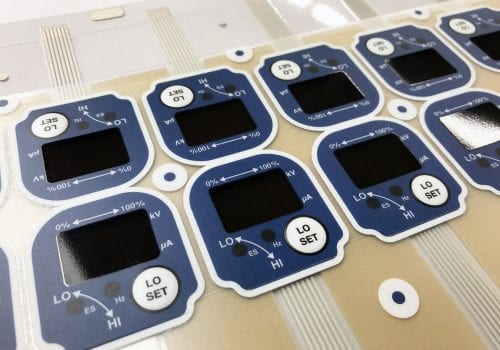Everything About Membrane Change: A Comprehensive Guide for Beginners
Membrane layer buttons are vital parts in modern-day electronics, providing an one-of-a-kind user interface for user communication - membrane switch. Their layered building and construction, including overlays and conductive traces, provides performance and sturdiness. Unlike traditional mechanical buttons, membrane switches offer a streamlined style and personalized options. Recognizing their essential attributes and benefits can transform item design. Nevertheless, the intricacies of their application and style factors to consider require more exploration
What Is a Membrane Change?
A membrane layer switch is a sort of electrical button that includes a flexible membrane layered over a published motherboard. This design permits a smooth and portable interface, typically made use of in numerous electronic devices. Membrane layer switches are typically found in consumer devices, medical equipment, and commercial machinery as a result of their durability and resistance to ecological factors.The building and construction commonly includes numerous layers, such as graphic overlays and glue support, which provide responsive responses and safeguard the wiring below. The operation of a membrane button is started when pressure is related to the surface area, finishing an electric circuit.These switches are valued for their convenience, allowing custom layouts and printed graphics that accommodate details interface. Their inconspicuous nature lowers room needs, making them ideal for applications where traditional buttons might not fit. In general, membrane layer switches use a functional and visual remedy for contemporary electronic tools.
Key Parts of Membrane Switches Over
Membrane switches over make up numerous essential parts that add to their functionality and performance. The leading layer, called the overlay, supplies the user interface and is typically published with graphics or signs. Underneath the overlay exists a spacer layer, which divides the conductive components and stops inadvertent activation. The next essential element is the visuals layer, which improves looks and assures the toughness of the design.Conductive traces, usually made from materials like silver or carbon, are published on the circuit layer. When pressure is related to the overlay, these traces come into contact, completing the circuit. Additionally, a support layer provides architectural support and can be made from products such as polyester or polycarbonate. Together, these elements create a trustworthy, user-friendly interface ideal for various applications, from household devices to industrial tools. Recognizing these aspects is necessary for any individual thinking about membrane layer button modern technology.
Exactly How Membrane Switches Over Work
Understanding exactly how membrane layer switches function is necessary for appreciating their extensive usage in numerous devices. A membrane button runs via a series of layers, including a graphic overlay, spacer, and a circuit layer. When stress is put on the overlay, it compresses the spacer layer, allowing the circuit layer to make get in touch with and finish an electric circuit. This activity sends out a signal to the device, prompting an action, such as activating a light or turning on a function.Membrane switches can be designed with various functions, including responsive responses, backlighting, and custom graphics, enhancing individual interaction. Their building permits a covered layout, shielding the inner parts from dirt, dampness, and contaminants. This resilience makes them appropriate for diverse applications, from consumer electronics to commercial tools. On the whole, the simpleness and performance of membrane layer switches over add to their popularity in contemporary innovation.
Advantages of Membrane Layer Switches Over Over Mechanical Buttons
While mechanical switches have long been a staple in many tools, membrane layer changes offer distinct advantages that make them significantly appealing. One substantial advantage is their slim profile, enabling more compact designs and greater flexibility in product advancement. In addition, membrane switches function an uniform surface, which improves aesthetic allure and streamlines cleaning, making them suitable for environments where health is critical.Another advantage is their resistance to dust and dampness. Unlike mechanical switches, which can be compromised by ecological aspects, membrane buttons offer a sealed user interface that safeguards against pollutants - membrane switch. Membrane layer buttons normally have a longer life expectancy due to less moving components, resulting in enhanced toughness and reliability.Cost-effectiveness is additionally a significant advantage, as membrane buttons can be generated in bulk with reduced production expenses. These variables combine to position membrane layer switches as a useful choice to traditional mechanical choices in numerous applications
Common Applications of Membrane Changes
Membrane layer switches are commonly utilized in numerous sectors, especially in customer electronic devices and commercial control panels. In consumer gadgets, they give a streamlined, user-friendly user interface, while in industrial settings, they boost sturdiness and capability. Understanding these applications highlights the flexibility and functionality of membrane layer buttons in modern-day technology.
Consumer Electronic Devices Tools
As customer electronic devices proceed to develop, membrane layer buttons have actually come to be a popular choice for a variety of devices due to their flexibility and sleek design. These switches are typically found in smartphones, tablets, and remote controls, where space is limited and looks issue. Their low profile and customizable designs allow manufacturers to create straightforward user interfaces that boost the overall user experience. Additionally, membrane buttons are commonly utilized in home appliances such as microwaves and coffee makers, providing intuitive control alternatives while withstanding wetness and dirt. The durability and integrity of membrane layer changes make them suitable for everyday customer products, making certain long life and constant efficiency. Generally, their combination in consumer electronic devices reflects a mix of performance and modern layout.
Industrial Control Panels
The applications of membrane switches over prolong past consumer electronics, discovering considerable use in industrial control panels. These buttons are preferred for their resilience and resistance to harsh settings, making them optimal for manufacturing and procedure control settings. They supply a reputable user interface for operators to regulate machinery, screen processes, and change setups. Membrane buttons can be customized to fit specific operational demands, including functions like backlighting and responsive feedback, boosting user experience. Their inconspicuous style permits for combination right into numerous equipment, while their capability to stand up to spills, dirt, and extreme temperature levels warranties longevity. Generally, membrane layer buttons contribute to effective and secure operation in commercial applications, showing their versatility and efficiency in requiring settings.
Considerations for Designing Membrane Changes
When making membrane layer buttons, selecting the best materials is necessary to assure durability and functionality. Furthermore, comprehending layer setup strategies can substantially impact the switch's efficiency and user experience. These considerations play an important duty in developing effective and dependable membrane layer switch styles.
Material Selection Significance
Material selection plays an important role in the design and functionality of membrane layer buttons. The selected materials directly affect the button's longevity, responsive action, and general aesthetic. Key considerations consist of the substratum, which should offer structural honesty while enabling for versatility, and the graphic overlay, which requires to be resistant to use and ecological aspects. Conductive materials should assure trusted electric performance, while adhesives have to use strong bonding without compromising the button's procedure. Additionally, compatibility with manufacturing procedures and end-user environments is vital; products should withstand differing temperatures, moisture levels, and chemical direct exposure. Eventually, appropriate product selection not just enhances the membrane layer switch's efficiency but additionally adds to its long life and customer complete satisfaction, making it an important aspect of the design see this website process.

Layer Arrangement Methods

Regularly Asked Questions
How Much Time Do Membrane Changes Generally Last?
Membrane layer buttons typically have a life-span of 1 to 5 million cycles, depending on usage and ecological conditions. Elements such as layout quality and operating frequency considerably affect their resilience and total efficiency longevity.

Can Membrane Switches Be Customized for Details Layouts?
Membrane switches can without a doubt be tailored to fit specific layouts, enabling diverse forms, colors, and functionalities. This convenience allows producers to tailor these buttons to meet one-of-a-kind visual and operational needs efficiently.
What Products Are Utilized in Membrane Change Construction?
Membrane buttons are generally created making use of products such as polyester, polycarbonate, and adhesive layers. These materials give resistance, flexibility, and durability to click here to find out more ecological factors, guaranteeing the switches work properly in various applications and conditions.
Are Membrane Layer Switches Over Immune or water-proof to Wetness?
Membrane buttons can be developed to be moisture-resistant, utilizing specialized coverings and products. However, their water resistant capacities rely on building and construction quality and particular applications, making it essential to assess demands for ideal performance in various settings.
Exactly How Are Membrane Switches Repaired if Harmed?
Fixing damaged membrane layer changes usually involves changing the impacted layer or circuit. Specialists may likewise apply conductive adhesive or make use of specialized repair kits, making sure capability is brought back without complete substitute of the entire switch assembly. Unlike conventional mechanical buttons, membrane layer buttons offer a streamlined style and customizable choices. A membrane switch is a kind of electrical switch that is composed of a versatile membrane layer layered over a published circuit board. The procedure of a membrane layer switch is launched when stress is used to the surface area, finishing an electrical circuit.These switches are valued for their adaptability, enabling personalized layouts and printed graphics that cater to certain customer interfaces. While mechanical buttons have actually long been a staple in numerous devices, membrane layer switches offer distinctive advantages that make them progressively appealing. Membrane layer switches generally have a longer life expectancy due to fewer moving parts, resulting in enhanced resilience and reliability.Cost-effectiveness is also a remarkable advantage, as membrane buttons can be generated in mass with lower production costs.